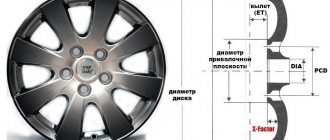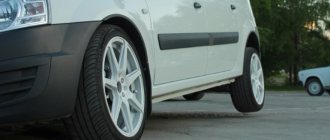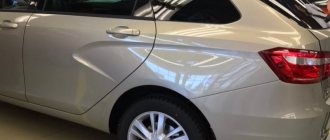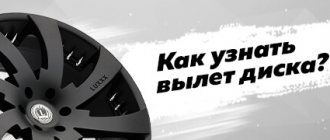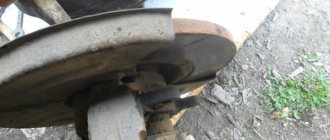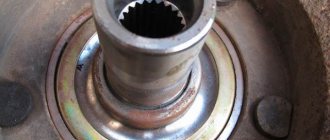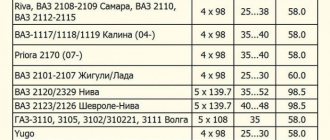12.07.2021
Most car enthusiasts are thinking about changing the appearance of their vehicle. Often they want to replace factory wheels with alloy ones. When choosing an element, some people only pay attention to the design and diameter. Before going to the store and tuning your car, you need to consult with an experienced specialist. He will advise you to take into account other important quantities that affect the technical condition of the vehicle. Disc offset (ET) is an important value to consider.
What is ET
Let's figure out what ET on rims is and what role this value plays. Car enthusiasts who have recently bought a car most likely do not yet know how important this parameter is. This value can be seen on the rim of the element; it is determined by the manufacturer. The parameter means the distance from the central point on the disk to the place where it is attached to other components of the mechanism. This size is determined by the manufacturer.
The lower the ET value, the more visible the wheel will be from the outside. Given the value of ET, the degree of load on the wheel will be distributed differently. This value is considered an important characteristic for the disk. It affects the safety of the driver and other people while driving. If the offset is selected incorrectly, the main components of the vehicle will quickly fail.
Very often, car enthusiasts make the following mistakes:
- They buy attractive items without taking into account the required characteristics.
- They rely entirely on consultants at the point of sale, who cannot always provide correct information.
- They don't take the labeling into account.
As a result, the mechanism breaks down prematurely and the person exposes himself to danger.
Different "departure"
There is another question: “Why can’t you install disks in front with one offset and in the rear with another?” This is generally not strictly prohibited, but only if it is done correctly. The rear wheelbase of the car should either be the same as the front, or wider, but in no case narrower. This is an important point to remember well. This is the golden rule. As soon as the front wheels are wider than the rear wheels, the car will have a skidding effect when turning - the rear will “run around” all the time. If the car owner increases the wheelbase of the rear wheels, then, on the contrary, the car acquires increased stability in corners.
Types of ET on cars
We previously looked at what offset is on alloy wheels, now let’s look at the main types of this important parameter. The following types of this quantity are distinguished:
- negative;
- positive;
- zero.
The first type means that the surface for fastening elements is placed beyond the boundaries of the located axis of the component. The second is that the wheel axle is located remotely from the junction with other elements, the third is that the axle and the mounting plane have the same values. The manufacturer often installs elements with a positive value, while negative ones are less common. On SUVs or trucks, a value of zero is more common. To properly design a drive, you need to use a special formula for this.
Additional markings of disks and decoding of their designations
The parameters listed above are fundamental when choosing a wheel for a car. However, on some of them you can find additional inscriptions and markings. For example:
- MAX LOAD. This abbreviation means what is the maximum permissible load allowed for a particular wheel rim. Typically the number is expressed in pounds (LB). To convert a value in pounds to a value in kilograms, simply divide by a factor of 2.2. For example, MAX LOAD = 2000 LB = 2000 / 2.2 = 908 kilograms. That is, disks, like tires, have a load index.
- MAX PSI 50 COLD. In this particular example, the inscription means that the maximum allowable air pressure in the tire mounted on the rim should not exceed 50 pounds per square inch (PSI). For reference, pressure equal to one kilogram-force is approximately 14 PSI. To convert the pressure value, use a calculator. That is, in this particular example, the maximum permissible tire pressure should not exceed 3.5 atmospheres in the metric coordinate system. And the inscription COLD means that the pressure must be measured in a cold tire (before the car starts moving, including not under the scorching sun).
- FORGET. This inscription means that a particular disc was made using the forging method (that is, forged).
- BEADLOCK. This means that the wheel is equipped with a so-called tire locking system. Currently, it is prohibited to use such disks for security reasons, so they are no longer commercially available.
- BEADLOCK SIMULATOR. Such an inscription indicates that the disk contains a simulator of the tire fixation system. In this case, such disks can be used everywhere. In practice, this means that these disks are no different from ordinary ones.
- SAE/ISO/TUV. These abbreviations refer to the standards and regulatory bodies to which the discs were manufactured. On domestic tires you can sometimes find GOST values or manufacturer specifications.
- Date of manufacture. The manufacturer indicates the corresponding production date in encrypted form. This is usually four digits. The first two of them mean the week in a row, starting from the beginning of the year, and the second two - the year of manufacture itself. For example, the designation 1217 indicates that the disc was manufactured in the 12th week of 2022.
- Country of manufacture. On some discs you can find the name of the country in which the product was manufactured. Sometimes manufacturers only leave their logo on the disc or simply write the name.
Markings on Japanese wheels
On some discs produced in Japan, you can find the so-called JWL marking. Translated from English, the abbreviation means Japanese alloy wheels. This marking is applied only to those discs that are sold in Japan. Other manufacturers may apply the appropriate abbreviation if desired. However, if it is on the disk, it means that the disk meets the requirements of the Ministry of Land, Infrastructure, Transport and Tourism of Japan. By the way, for trucks and buses the similar abbreviation will be slightly different - JWL-T.
There is another non-standard marking - VIA. It is applied to the disc only if the product has passed successful tests in the laboratory of the Japanese Transport Inspection. The abbreviation VIA is an officially registered trademark. Therefore, applying it to discs that have not passed the appropriate tests is punishable. Therefore, discs on which the indicated abbreviation is printed will initially be of very high quality and durable.
What does the ET value affect?
Manufacturers, even at the stage of drawing up projects, calculate the possibility of deviations from the norm and indicate possible sizes. If the car enthusiast follows all the necessary parameters during the installation of elements, he will be able to avoid mistakes and also ensure that all the required values coincide. We will consider later what permissible disc offset deviations are possible.
ET affects the symmetrical arrangement of the wheels. Most store sellers are not aware of or hide the importance of accounting for ET on the technical condition of the vehicle. If the value is selected incorrectly, this may contribute to the following dangerous situations:
- Reducing the period of use of the chassis and other components of the mechanism.
- Excessive tire wear.
- Deformation of the steering axis.
- Reducing the service life of a running vehicle.
- Deterioration in vehicle controllability.
The manufacturer regulates this value and choosing another is undesirable. After all, each design has its own unique parameters. Each vehicle has its own ET value. If it is not observed, the wheel may rub against the car body or touch other suspension elements.
What problems can arise due to incorrect selection of disks?
The danger of incorrect selection of this dimension is especially relevant when operating expensive modern cars. Thus, the position of the vehicle on the road is carefully monitored by the on-board computer and various sensors. If a tire goes flat, the driver receives a signal about a loss of pressure; when the brake pedal is pressed sharply, the wheels do not lock, as the ABS is activated.
The same can be said about the directional stability stabilizer, which controls the position of the car on the road and the straightness of its movement, and also prevents skidding on the road, alternately blocking one or another wheel. In this computer, as a rule, engineers enter certain indicators of the wheel rim dimensions - ET, and as the final result - the values of bending moments.
Measuring the jack of the disc
Independent calculation of values
To find out the ET on car rims, you need to use the following formula: add the distance between the inner side of the element, the surface of its contact with other components of the mechanism and its width. Divide the resulting value by two and subtract the width of the element.
Before making calculations, you need to take an even flat block, slightly longer than the diameter of the component being measured, and a ruler. If the wheel is installed on the vehicle, it must be removed. After dismantling, the element is turned over with its outer side and a block is applied. Then, using a ruler, measure the distance from the central part to the bottom of the block. This will be the necessary distance for further calculations. For example, it will be equal to 115 mm.
To calculate the width, you need to turn the disc with the front side and attach the rail to the rim. As a result, we get the desired width. For example, it is 101 mm. As a result, we get the following answer: ET=(115+101)/2-101=7mm
How is the width of a wheel rim indicated?
The width of the rim is indicated in the rim parameters line. For example, let’s take a look at the wheel markings from the VAZ-2110, which are designated as follows: 5Jx14/ET35/4×98/DIA 58.6. The first number is 5, this is the size of the rim width. Distance is measured in inches. To convert it to centimeters, you need to multiply the value by 2.54 cm. In our case: 5 x 2.54 = 12.7 cm. This is the distance between the inner edges.
The most common rims are available in widths from 5 to 10 inches. And the most common type of flange is “J” or “JJ” (SUVs). The marking is applied to the rim itself: for steel “stampings” on the outside, and for light-alloy wheels – inside the cavities of the spokes. To avoid cleaning a dirty wheel, the parameters can be found in the car’s operating instructions. Also, the automaker places information plates on the car body with dimensions that can most often be found in places such as:
- glove box (glove compartment);
- reverse side of the fuel filler flap;
- driver's door pillar.
If you install wider wheels, you will have to buy wider tires. A moderate sizing error, just 1-1.5 inches larger, will give the vehicle better directional stability. If you install the rims much wider, the tires will begin to touch the wheel arch and fender arch.
A narrower rim width than recommended by the manufacturer reduces the vehicle's directional stability. The car will start to “float” on the road because the tires will be too big for the rim. If you select tires for wheels in accordance with the rules, then it is recommended to install wheels a little narrower in the winter, and wider in the summer.
Possibility of installing a disk with a lower ET value
What is ET offset on alloy wheels was discussed above. Now let's figure out whether it is possible to supply an element with a lower ET. Some experts involved in the sale of discs claim that this value does not affect the car mechanism. They are mistaken. Models of units may have various components installed by the manufacturer. If a different engine is installed on the vehicle, this will affect the entire structure as a whole. Experienced craftsmen carry out calculations of the value for each configuration separately.
If you need to mount disks with another ET on a vehicle, you can use special devices. They are a circle of metal with different thicknesses. If a person selects the required thickness, he does not have to worry about the performance of the chassis. If a motorist decides to change wheels, you need to take into account the offset on the car's rims. This parameter can be viewed on the element itself. If there is no required marking, the car enthusiast can determine it himself using the necessary formula. To select and install tires, you must adhere to the manufacturer's recommendations.
Labeling and formula
Calculations should be made using the formula:
ET=(A+B) / 2
The values obtained during the measurement must be substituted into it.
The ET value is prescribed individually for each machine. All the necessary information on this matter is in the car’s operating instructions. Wheels will not fit the vehicle if the measured value differs from the data in this document. “Non-native” components are not worth buying, even if the seller actively convinces you otherwise.
The markings on the discs must be carefully studied - this is the only way to make sure that they are safe to use. Product markings are standard. In any case, the designation contains the letter I or S. The letter I means that the wheel is “identical” and is installed on production cars. S indicates that the wheel is special, that is, its certification is not tied to a specific brand of car. In some cases, there is no letter designation - instead, the name of the plant where the car was made and its catalog number are applied to the rim.
As an example, consider the rim marker 7.5 j x16 H2 5/112 ET 35 d 66.6:
- The first numbers are the width of the disk. For example, 7.5 means the width is 7.5 inches. To convert to centimeters, you need to multiply by 2.54.
- The letter J means that the wheel has some design features. This information is of no interest to consumers.
- X indicates the indivisibility of the disk.
- The number 16 is the wheel caliber corresponding to the tire caliber.
- H2 reports that there are 2 humps on the rim.
- The number 5 is the number of holes for fasteners, 112 is the diameter at which they are located.
- ET 35 speaks of a plus offset, the size of which is 35 mm.
- d 66.6 - central hole gauge. Ideally it should be identical to the hub caliber. If this is not the case, an additional ring must be used to center the fit. It is also called transitional.
Permissible deviation of value
Each manufacturer sets its own acceptable parameters for different brands of cars. They will depend on the characteristics of the frame, wheel arches, suspension and other elements of the vehicle’s chassis. Each mount has its own indicator of compatibility of different sizes. You can familiarize yourself with the permissible deviation values in books, instructions or on the Internet.
Domestic VAZ cars are considered universal, with the only exception being the Niva. The ET difference for these models ranges from 35-38 mm. These values correspond to the size of global concerns. It is worth noting that on SUVs the ET is always negative. The larger the value, the more the wheels stick out on the sides of the body. This helps to increase the stability of the car on difficult sections of the road. In addition, in such units the suspension is reinforced, and the bolt pattern is 5*115.
If the indicator is exceeded, this will lead to deformation of the chassis. Owners of budget cars often face this problem. However, drivers who drive business class cars also run the risk of choosing the wrong disc. In such vehicles, all processes of the mechanism are controlled by an on-board computer. Manufacturers provide certain ET values. If the car owner does not take this value into account, a malfunction may occur and the computer will suddenly lock the wheels while driving. As a result, the driver may get into an accident and lose control of the vehicle.
ET affects the performance of all main components of the vehicle. An incorrectly selected element has a negative impact on the car’s stability and handling and can lead to serious consequences. If the ET differs from the factory one, this can be corrected using special tools.
avtoexperts.ru
A very interesting thing happens with wheel rims. Ask car owners what wheel parameters they have on their car and you will get unusual results. Even motorists who are far from materiel and technical nuances know what diameter of the disks on their car; many will name the number of mounting bolts and the distance between the bolts, but few will be able to answer about such a parameter as disk offset. But meanwhile, this is as important a nuance as the size, bolt pattern and diameter of the central hole. It’s just that if these three parameters do not match, then the disk cannot be installed on the machine at all, but the error in ejection is insidious - the disk will become without problems, but problems will begin during operation.
Alloy wheel
What is disc ejection?
The “disc offset” parameter has complex explanations, but in simple terms, it is the relationship between the central axis of the disc and the location where the disc is attached to the hub. If the disk is mounted in the very middle, then the offset is zero, if the mount is located closer to the outside of the disk (and most of the disk is hidden in the car itself), such an overhang is considered positive, and if the mount is located closer to the inside of the disk (large part of the disk protrudes outward), then the overhang is considered negative. Many people have probably seen “tuned” cars in which the rims protrude greatly from the body, but they just have rims with a negative offset.
Disc offset
Offset is measured in millimeters; in wheel markings it is denoted by the abbreviation ET. Look at what is written in the specifications of the wheels for your car, so you will know what offset wheels should be installed on your car.
Why change the offset?
It would seem that everything is simple - there is a value prescribed by the factory, and we set it, however, cases of installing wheels with abnormal offset are quite common. In general, they can be divided into two groups - deliberately changing parameters and buying the wrong disks.
Disk parameter designation
When deliberately changing the offset of discs, three possible goals are usually pursued - changing the appearance, giving the car individuality and expressiveness, installing wider tires that would cling to the suspension elements with a standard offset, increasing the vehicle's track width to improve stability and reduce the risk of rollover. Even if we abstract from appearance, it is possible to find advantages from wheels with a large offset, but only if the owner clearly understands what he is doing and is aware of the risks that inevitably arise.
It’s worse when wheels with a different offset are purchased by mistake. Such cases, alas, are not uncommon. This is due to the widespread belief that a slight deviation from the standard offset does not affect the car and suspension in any way, so you can safely buy wheels with an offset 5-10 millimeters more or less than the standard one. Unfortunately, this point of view is often supported by consultants in tire services, who need to fulfill a sales plan, and a crash can become an obstacle to a client’s purchase of wheels. The situation is aggravated by the fact that we have already cited above - not all motorists know the offset of their wheels.
Negative wheel offset
Risks when using wheels with a different offset
The question immediately arises - if by selecting the offset of the discs you can change the characteristics of the car, then why not use it. Alas, this procedure has not only advantages, but also disadvantages, and the latter are very significant. The main nuance is that when designing the suspension, engineers start from wheels with a certain offset. It is on them that the parameters of the elements are calculated, strength, reliability and service life are estimated. Disc offset works in conjunction with the choice of shock absorbers, springs, camber, castor and other parameters. By changing one indicator, the owner of the car destroys the entire idea of the designers, deprives the car of balance, and it is unknown what this may turn out to be. When designing even the most budget car, a huge number of tests and calculations are carried out, and the owner installs the wheels “by eye”.
Some detrimental changes are quite obvious. Changing the reach shifts the steering axis and the maximum wheel turning angles, this will almost certainly change the turning radius for the worse, the reaction to the steering wheel will change, and handling may deteriorate. And, in addition, the distribution and direction of loads in the suspension will no longer be the same as planned, which means that some elements will work in a more complex mode and break earlier than with the “necessary” disks. Usually, a change in offset has a detrimental effect on the life of wheel bearings, but it is difficult to predict; other elements may also be affected. It is no coincidence that when using non-standard wheels, the car is removed from the suspension warranty, this is completely fair.
Toyota Camry XV40 on non-standard wheels with 225/30/R20 tires
Another side effect of using a non-standard offset is increased tire wear, often very uneven. This cannot be cured by falling apart.
Replacing wheels is considered the simplest tuning because it is simple and does not require large financial costs. However, all experiments with wheels must be carried out within the manufacturer’s tolerances, and they are usually very small; for example, no car company allows changing the offset, and not without reason. A wheel with a different offset, even if it doesn’t seem to differ very much, changes the suspension parameters. This threatens to deteriorate handling and accelerated wear of the suspension. Is it worth it to achieve external effect and attract attention? It seems to us - no. If it is wise to use wheels with a different offset, it is only on specialized sports and jeep cars that rarely drive on public roads, and only by experienced tuners who know what they are doing.
Tuned Jeep Wrangler SUV on custom wheels
